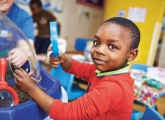Barbara Isaacs offers ideas on using the Montessori approach to foster children’s independence and sense of responsibility in nursery settings…
The Montessori approach encourages children to be independent in every aspect of their life at nursery. We give them opportunities to make choices about their activities. This means that spontaneous engagements with the environment and child-led activities flourish.
A Montessori approach means promoting freedom of choice, on the understanding that there are also some rules linked with the freedom. For example, children must make sure that they leave activities ready for another child to use.
This type of social focus promotes freedom with responsibility, as well as social awareness and initiative. Once children know the routine, they are in charge.
This Montessori approach requires consistency from adults, as well as an understanding that we need to show, help and remind children and give them time to undertake tasks such as washing up after a snack.
Also remember that children may not do the job to our adult expectation. They need opportunities to develop competence through repetition. The bonus for the child is a feeling of achievement, and control over their actions and environment.
There are many routines in the daily life of a classroom with a Montessori approach that promote this sense of achievement. For example:
Encourage children to think about their friends by returning activities where they found them. For example, ask them to place books back on the bookshelf or make sure that they return unused resources from the art trolley to their appropriate boxes and baskets.
A good example of such a routine is painting and washing the easel afterwards. As most children enjoy painting and using water, this routine offers you a perfect opportunity to introduce the whole cycle of activity, starting with deciding to paint and finishing by leaving a clean easel and washing one’s hands.
Consider the sequence of steps required for this activity and how they support all aspects or learning and development:
Each step also requires its own skills and procedures. Indeed they involve an array of problem-solving, remembering, thinking and physical skills.
This method also requires a different approach from us as adults. We need to make sure that the environment is ready and enables children to perform all these steps on their own.
For example, are the aprons, paper and paints ready for use? Is the picture drying area accessible and manageable for children? Are the bucket, sponge and mop nearby?
Just imagine the child’s face at the end: a triumph of autonomy!
If you are tempted to try this, but are anxious about it working, why not try it as part of your outdoor activities first?
You will be amazed at how eager children will be to participate. If you persevere, you will be able to introduce it inside within a couple of months. Why not empower the children to be in charge of their painting activities?
Barbara Isaacs is the academic director of Montessori Centre International.

Exploring the World in Montessori Early Years Settings
Editors picks

Pirate activities EYFS – 18 science-themed ideas to try
Editors picks
